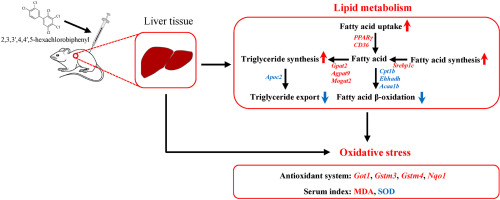当前位置:
X-MOL 学术
›
Environ. Pollut.
›
论文详情
Our official English website, www.x-mol.net, welcomes your
feedback! (Note: you will need to create a separate account there.)
Exposure to 2,3,3',4,4',5-hexachlorobiphenyl promotes nonalcoholic fatty liver disease development in C57BL/6 mice.
Environmental Pollution ( IF 7.6 ) Pub Date : 2020-04-09 , DOI: 10.1016/j.envpol.2020.114563 Qiuli Shan 1 , Ningning Chen 2 , Wei Liu 3 , Fan Qu 2 , Anhui Chen 4
Environmental Pollution ( IF 7.6 ) Pub Date : 2020-04-09 , DOI: 10.1016/j.envpol.2020.114563 Qiuli Shan 1 , Ningning Chen 2 , Wei Liu 3 , Fan Qu 2 , Anhui Chen 4
Affiliation

|
Previous in vitro studies have indicated that 2,3,3',4,4',5-hexachlorobiphenyl (PCB 156) may be a new contributor to metabolic disruption and may further cause the occurrence of nonalcoholic fatty liver disease (NAFLD). However, no study has clarified the specific contributions of PCB 156 to NAFLD progression by constructing an in vivo model. Herein, we evaluated the effects of PCB 156 treatment (55 mg/kg, i.p.) on the livers of C57BL/6 mice fed a control diet (CD) or a high-fat diet (HFD). The results showed that PCB 156 administration increased intra-abdominal fat mass, hepatic lipid levels and dyslipidemia in the CD-fed group and aggravated NAFLD in HFD-fed group. By using transcriptomics studies and biological methods, we found that the genes expression involved in lipid metabolism pathways, such as lipogenesis, lipid accumulation and lipid β-oxidation, was greatly altered in liver tissues exposed to PCB 156. In addition, the cytochrome P450 pathway, peroxisome proliferator-activated receptors (PPARs) and the glutathione metabolism pathway were significantly activated following exposure to PCB 156. Furthermore, PCB 156 exposure increased serum transaminase levels and lipid peroxidation, and the redox-related genes were significantly dysregulated in liver tissue. In conclusion, our data suggested that PCB 156 could promote NAFLD development by altering the expression of genes related to lipid metabolism and inducing oxidative stress.
中文翻译:

暴露于2,3,3',4,4',5-六氯联苯可促进C57BL / 6小鼠的非酒精性脂肪肝疾病的发展。
先前的体外研究表明,2,3,3',4,4',5-六氯联苯(PCB 156)可能是导致代谢破坏的新因素,并可能进一步引起非酒精性脂肪性肝病(NAFLD)的发生。但是,尚无研究通过构建体内模型来阐明PCB 156对NAFLD进展的具体作用。在本文中,我们评估了PCB 156处理(55 mg / kg,腹膜内)对饲喂对照饮食(CD)或高脂饮食(HFD)的C57BL / 6小鼠肝脏的影响。结果表明,CD喂养组服用PCB 156会增加腹内脂肪量,肝脂质水平和血脂异常,而HFD喂养组会加剧NAFLD。通过使用转录组学研究和生物学方法,我们发现参与脂质代谢途径(如脂肪形成,暴露于PCB 156的肝组织中的脂质堆积和脂质β氧化发生了很大变化。此外,暴露于PCB 156后,细胞色素P450途径,过氧化物酶体增殖物激活受体(PPAR)和谷胱甘肽代谢途径被显着激活。 ,PCB 156暴露可增加血清转氨酶水平和脂质过氧化作用,并且肝脏组织中氧化还原相关基因显着失调。总之,我们的数据表明PCB 156可以通过改变与脂质代谢相关的基因的表达并诱导氧化应激来促进NAFLD的发展。暴露于PCB 156后,过氧化物酶体增殖物激活受体(PPAR)和谷胱甘肽代谢途径被显着激活。此外,PCB 156暴露会增加血清转氨酶水平和脂质过氧化作用,并且肝脏组织中氧化还原相关基因显着失调。总之,我们的数据表明PCB 156可以通过改变与脂质代谢相关的基因的表达并诱导氧化应激来促进NAFLD的发展。暴露于PCB 156后,过氧化物酶体增殖物激活受体(PPAR)和谷胱甘肽代谢途径被显着激活。此外,PCB 156暴露会增加血清转氨酶水平和脂质过氧化作用,并且肝脏组织中氧化还原相关基因显着失调。总之,我们的数据表明PCB 156可以通过改变与脂质代谢相关的基因的表达并诱导氧化应激来促进NAFLD的发展。
更新日期:2020-04-09
中文翻译:

暴露于2,3,3',4,4',5-六氯联苯可促进C57BL / 6小鼠的非酒精性脂肪肝疾病的发展。
先前的体外研究表明,2,3,3',4,4',5-六氯联苯(PCB 156)可能是导致代谢破坏的新因素,并可能进一步引起非酒精性脂肪性肝病(NAFLD)的发生。但是,尚无研究通过构建体内模型来阐明PCB 156对NAFLD进展的具体作用。在本文中,我们评估了PCB 156处理(55 mg / kg,腹膜内)对饲喂对照饮食(CD)或高脂饮食(HFD)的C57BL / 6小鼠肝脏的影响。结果表明,CD喂养组服用PCB 156会增加腹内脂肪量,肝脂质水平和血脂异常,而HFD喂养组会加剧NAFLD。通过使用转录组学研究和生物学方法,我们发现参与脂质代谢途径(如脂肪形成,暴露于PCB 156的肝组织中的脂质堆积和脂质β氧化发生了很大变化。此外,暴露于PCB 156后,细胞色素P450途径,过氧化物酶体增殖物激活受体(PPAR)和谷胱甘肽代谢途径被显着激活。 ,PCB 156暴露可增加血清转氨酶水平和脂质过氧化作用,并且肝脏组织中氧化还原相关基因显着失调。总之,我们的数据表明PCB 156可以通过改变与脂质代谢相关的基因的表达并诱导氧化应激来促进NAFLD的发展。暴露于PCB 156后,过氧化物酶体增殖物激活受体(PPAR)和谷胱甘肽代谢途径被显着激活。此外,PCB 156暴露会增加血清转氨酶水平和脂质过氧化作用,并且肝脏组织中氧化还原相关基因显着失调。总之,我们的数据表明PCB 156可以通过改变与脂质代谢相关的基因的表达并诱导氧化应激来促进NAFLD的发展。暴露于PCB 156后,过氧化物酶体增殖物激活受体(PPAR)和谷胱甘肽代谢途径被显着激活。此外,PCB 156暴露会增加血清转氨酶水平和脂质过氧化作用,并且肝脏组织中氧化还原相关基因显着失调。总之,我们的数据表明PCB 156可以通过改变与脂质代谢相关的基因的表达并诱导氧化应激来促进NAFLD的发展。






























 京公网安备 11010802027423号
京公网安备 11010802027423号